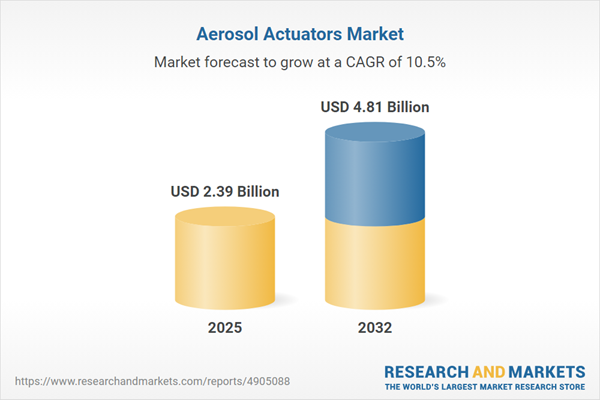Speak directly to the analyst to clarify any post sales queries you may have.
Senior leaders managing the aerosol actuators market face a landscape defined by shifting regulations, tightening sustainability standards, and a growing demand for supply chain resilience. Adaptability and precision in technological deployment are crucial for ensuring operational strength and supporting growth potential in such a dynamic sector.
Aerosol Actuators Market Snapshot: Growth, Size, and Outlook
The aerosol actuators market continues on an upward curve, reaching a value of USD 2.16 billion in 2024 and is projected to grow to USD 2.39 billion by 2025, with a further increase to USD 4.81 billion by 2032. This trajectory reflects a compound annual growth rate (CAGR) of 10.49%.
Major industry segments, including personal care, industrial, and pharmaceutical applications, are leveraging advanced dispensing technologies as a standard. Organizations are actively realigning business models and fortifying supply chains to address evolving environmental and performance requirements. Technology advancement and compliance integration are becoming central elements for executives focusing on operational agility and sustained competitiveness in the aerosol actuators market.Aerosol Actuators Market Scope & Segmentation
- Applications: Addresses needs in personal care, automotive, household, industrial, pharmaceutical, and food and beverage sectors, each responding to distinctive safety, efficacy, and regulatory criteria.
- Propellant Types: Covers chlorofluorocarbon, hydrocarbon, dimethyl ether, and compressed gas options, with notable movement toward alternative, environmentally responsible propellants to align with sustainability objectives.
- Actuator Types: Encompasses continuous spray, dome sprayers, finger triggers, metered dose, and flip top designs, providing tailored solutions for accuracy and ergonomic use.
- Distribution Channels: Includes online providers, specialty retail outlets, supermarkets, drugstores, and institutional suppliers, supporting expansive market access and customized regional approaches.
- Container Materials: Utilizes glass, aluminum, plastic, and steel containers, each selected for performance in durability, recyclability, aesthetics, and alignment with compliance priorities and brand strategy.
- End Users: Services commercial, residential, and industrial environments, with adaptability and safety features prioritized for each customer segment.
- Regions: Covers the Americas, Europe, Middle East and Africa, and Asia-Pacific, with differentiation rooted in local regulations, infrastructure readiness, and technology uptake.
- Company Coverage: Features key participants such as AptarGroup, Silgan Holdings, Berry Global, Recipharm AB, Precision Valve Corporation, Coster Group, Comar, Unilever, Aerosol Servco, and Procter & Gamble, whose collective strategic initiatives guide industry benchmarks and influence innovation dynamics.
Aerosol Actuators Market Key Takeaways
- Sustainability measures drive the adoption of recyclable materials and eco-friendly propellants, deepening industry commitment to environmental accountability.
- Integration of digital actuator technologies—including sensors and smart dispensing—improves traceability, vital for compliance-driven sectors and enhancing operational insights.
- Manufacturing enhancements, such as automation and advanced molding techniques, facilitate tailored actuator solutions and greater product reliability globally.
- Regional dynamics reflect disparate approaches, with Europe focusing on compliance and innovation, Asia-Pacific emphasizing large-scale manufacturing, and the Americas leveraging established supply and distribution infrastructures.
- Collaborative efforts among material science and engineering teams are streamlining actuator design, minimizing material waste, and reinforcing resilience in the supply chain to better respond to demand shifts.
- Transparent sustainability reporting strengthens trust with business partners and clients, reinforcing long-term alliances and bolstering market reputation.
Tariff Impact on Aerosol Actuator Supply Chains
Ongoing U.S. tariffs affecting imported aerosol actuator components are prompting organizations to rethink sourcing strategies and diversify supplier bases—often turning to regional manufacturing. Increased automation supports operational consistency and agility amid regulatory and tariff uncertainty.
Research Methodology & Data Sources
This research is based on direct consultations with industry engineers and supply chain specialists, supported by validated market datasets and relevant regulatory analysis. The methodology addresses the strategic information needs of executive leadership.
Why This Aerosol Actuators Market Report Matters
- Benchmarks advancements in sustainability practices and the integration of digital technologies, enabling readiness for regulatory and technological evolution.
- Equips leaders with actionable insights for managing risk, making informed investments, and supporting business continuity.
- Provides complete compliance and supply chain evaluations to strengthen market positioning and foster ongoing growth opportunities.
Conclusion
Maintaining a competitive position in the aerosol actuators market requires continuous commitment to sustainability, innovation, and regulatory compliance. Strategic focus and adaptability will help organizations thrive amid ongoing industry transformation.
Additional Product Information:
- Purchase of this report includes 1 year online access with quarterly updates.
- This report can be updated on request. Please contact our Customer Experience team using the Ask a Question widget on our website.
Table of Contents
3. Executive Summary
4. Market Overview
7. Cumulative Impact of Artificial Intelligence 2025
Companies Mentioned
The companies profiled in this Aerosol Actuators market report include:- AptarGroup, Inc.
- Silgan Holdings, Inc.
- Berry Global, Inc.
- Recipharm AB
- Precision Valve Corporation
- Coster Group S.p.A.
- Comar LLC
- Unilever PLC
- Aerosol Servco (Pty) Ltd.
- The Procter & Gamble Company
Table Information
| Report Attribute | Details |
|---|---|
| No. of Pages | 195 |
| Published | November 2025 |
| Forecast Period | 2025 - 2032 |
| Estimated Market Value ( USD | $ 2.39 Billion |
| Forecasted Market Value ( USD | $ 4.81 Billion |
| Compound Annual Growth Rate | 10.4% |
| Regions Covered | Global |
| No. of Companies Mentioned | 11 |









